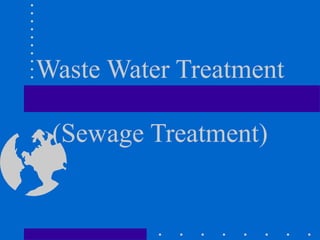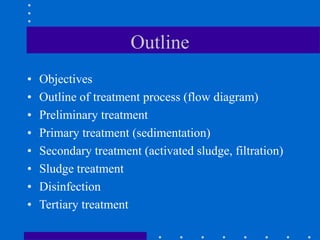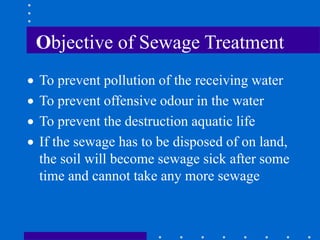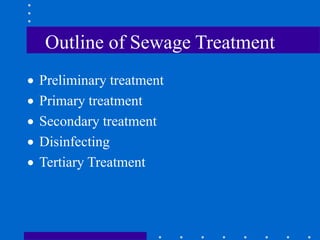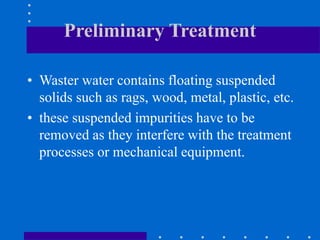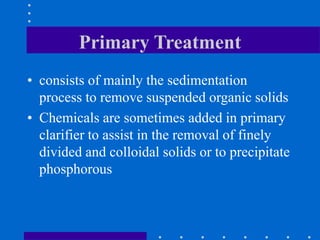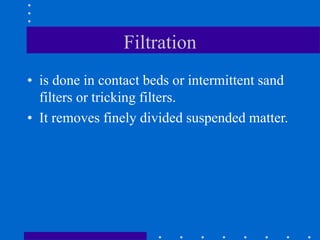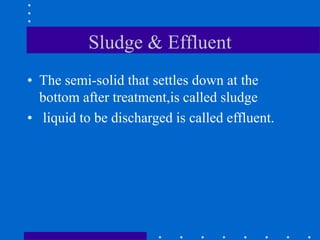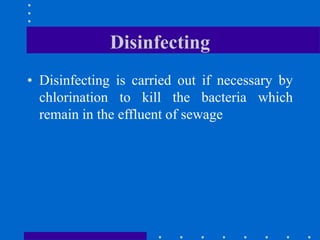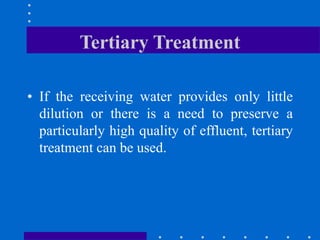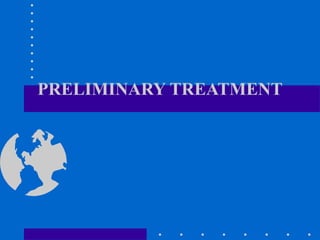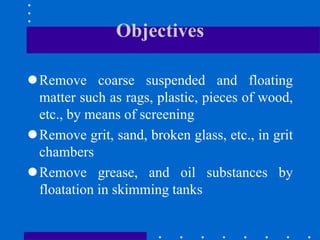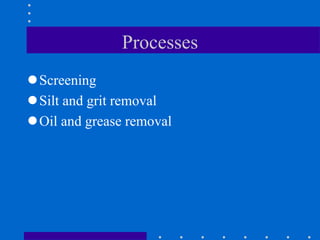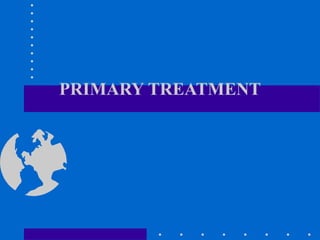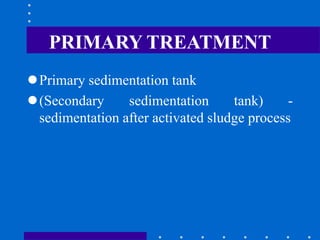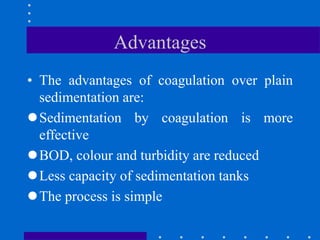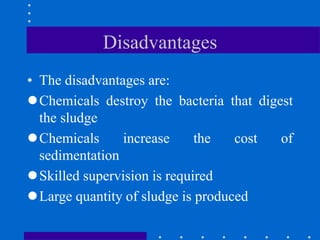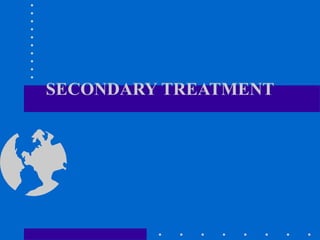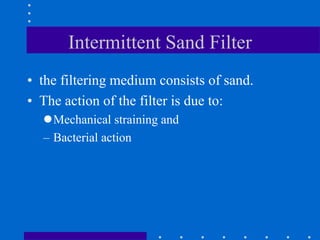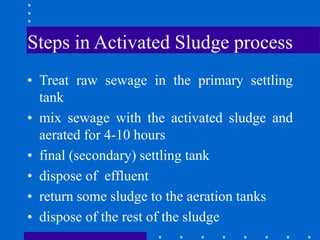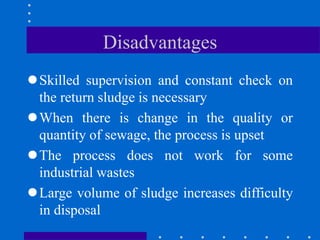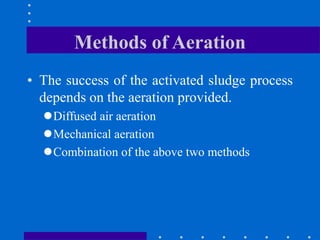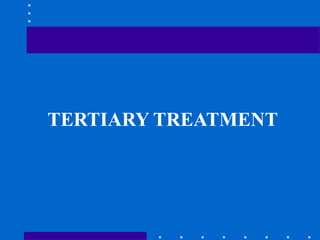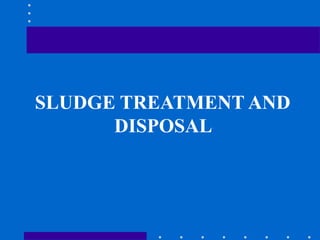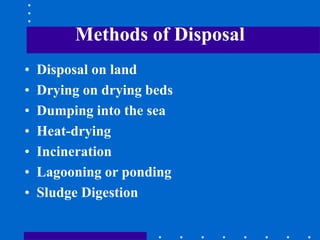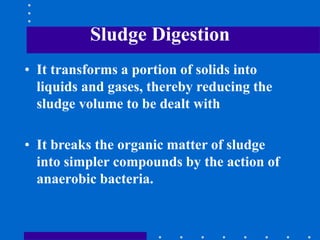Waste Water Treatment Secondary treatment (activated sludge, filtration).ppt
- 1. Waste Water Treatment (Sewage Treatment)
- 2. Outline • Objectives • Outline of treatment process (flow diagram) • Preliminary treatment • Primary treatment (sedimentation) • Secondary treatment (activated sludge, filtration) • Sludge treatment • Disinfection • Tertiary treatment
- 3. Objective of Sewage Treatment To prevent pollution of the receiving water To prevent offensive odour in the water To prevent the destruction aquatic life If the sewage has to be disposed of on land, the soil will become sewage sick after some time and cannot take any more sewage
- 4. Outline of Sewage Treatment Preliminary treatment Primary treatment Secondary treatment Disinfecting Tertiary Treatment
- 5. Preliminary Treatment • Waster water contains floating suspended solids such as rags, wood, metal, plastic, etc. • these suspended impurities have to be removed as they interfere with the treatment processes or mechanical equipment.
- 6. Primary Treatment • consists of mainly the sedimentation process to remove suspended organic solids • Chemicals are sometimes added in primary clarifier to assist in the removal of finely divided and colloidal solids or to precipitate phosphorous
- 7. Secondary or Biological Treatment • Activated sludge process • Filtration
- 8. Activated sludge process • the sewage is biologically treated.
- 9. Filtration • is done in contact beds or intermittent sand filters or tricking filters. • It removes finely divided suspended matter.
- 10. Sludge & Effluent • The semi-solid that settles down at the bottom after treatment,is called sludge • liquid to be discharged is called effluent.
- 11. Disinfecting • Disinfecting is carried out if necessary by chlorination to kill the bacteria which remain in the effluent of sewage
- 12. Tertiary Treatment • If the receiving water provides only little dilution or there is a need to preserve a particularly high quality of effluent, tertiary treatment can be used.
- 14. Objectives Remove coarse suspended and floating matter such as rags, plastic, pieces of wood, etc., by means of screening Remove grit, sand, broken glass, etc., in grit chambers Remove grease, and oil substances by floatation in skimming tanks
- 15. Processes Screening Silt and grit removal Oil and grease removal
- 17. PRIMARY TREATMENT Primary sedimentation tank (Secondary sedimentation tank) - sedimentation after activated sludge process
- 18. Advantages • The advantages of coagulation over plain sedimentation are: Sedimentation by coagulation is more effective BOD, colour and turbidity are reduced Less capacity of sedimentation tanks The process is simple
- 19. Disadvantages • The disadvantages are: Chemicals destroy the bacteria that digest the sludge Chemicals increase the cost of sedimentation Skilled supervision is required Large quantity of sludge is produced
- 21. SECONDARY TREATMENT • The secondary treatment converts the remaining organic matter into stable form by putting aerobic and anaerobic bacteria into action
- 23. Filtration • Aerobic bacteria need a contact surface to live and carry out their activities
- 24. Filtration Contact beds Intermittent sand filters Trickling filters
- 25. Contact Beds • A contact bed consists of filtering medium. • When the sewage is passed over the medium, a thin film is produced around the particles. • The bacteria present in the film oxidise the organic matter.
- 26. Intermittent Sand Filter • the filtering medium consists of sand. • The action of the filter is due to: Mechanical straining and – Bacterial action
- 27. Trickling Filters • A trickling filter is an artificial bed of stone or broken brick material • waste water is distributed an applied in drops, films or spray • A zoogleal film is formed on the surface media.
- 28. ACTIVATED SLUDGE PROCESS • is a biological sewage treatment process • a mixture of sewage and activated sludge is agitated and aerated. • The activated sludge is subsequently separated from the treated sewage by sedimentation
- 29. What is ACTIVATED SLUDGE • is that sludge which settles down after the sewage has been freely aerated and agitated for a certain time.
- 30. How Activated Sludge works • Activated sludge contains numerous bacteria and other microorganisms. When it is mixed with raw sewage saturated with oxygen, the bacteria perform: – Oxidise the organic solids Promote coagulation and flocculation and convert the colloidal and suspended solids into settable solids
- 31. Steps in Activated Sludge process • Treat raw sewage in the primary settling tank • mix sewage with the activated sludge and aerated for 4-10 hours • final (secondary) settling tank • dispose of effluent • return some sludge to the aeration tanks • dispose of the rest of the sludge
- 32. Advantages • Gives clear sparkling treated effluent • Effluent free from offensive odour • Degree of purity can be varied as desired • Cost of installation lesser than for a trickling filter • Small loss of head in the process
- 33. Disadvantages Skilled supervision and constant check on the return sludge is necessary When there is change in the quality or quantity of sewage, the process is upset The process does not work for some industrial wastes Large volume of sludge increases difficulty in disposal
- 34. Methods of Aeration • The success of the activated sludge process depends on the aeration provided. Diffused air aeration Mechanical aeration Combination of the above two methods
- 36. TERTIARY TREATMENT • MICROSTRAINERS • RAPID GRAVITY SAND FILTERS • UPWARD-FLOW “MEDUIM” SAND FILTERS • SLOW SAND FILTERS • PEBBLE-BED CLARIFIERS • SETTLEMENT • GRASS PLOTS • LAGOONS
- 38. Sludge • Sludge is a semi-liquid • Sludge produced by plain sedimentation • Sludge produced by chemical precipitation • Trickling filter • Activated sludge
- 39. Methods of Disposal • Disposal on land • Drying on drying beds • Dumping into the sea • Heat-drying • Incineration • Lagooning or ponding • Sludge Digestion
- 40. Sludge Digestion • It transforms a portion of solids into liquids and gases, thereby reducing the sludge volume to be dealt with • It breaks the organic matter of sludge into simpler compounds by the action of anaerobic bacteria.
